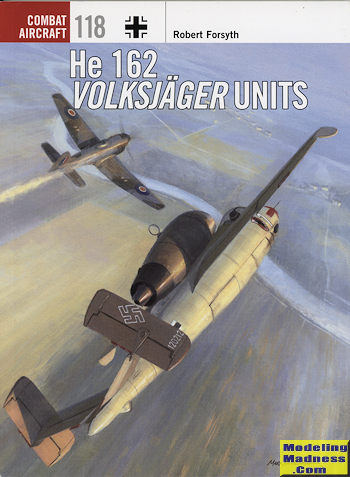 The
He-162 was one of those aircraft that was born of favoritism, produced in a
remarkably short amount of time and made absolutely no difference on the outcome
of the war other than to kill or injure several of its pilots.
The
He-162 was one of those aircraft that was born of favoritism, produced in a
remarkably short amount of time and made absolutely no difference on the outcome
of the war other than to kill or injure several of its pilots. |
Author: |
Robert Forsyth |
|
Publisher/Distributor |
Osprey Publishing |
|
Price |
$23.00 MSRP |
|
Reviewer: |
|
| Notes: |
96 pages, 7¼ x 9¼ inches, softbound ISBN: 978-1-4728-1457-9 |
 The
He-162 was one of those aircraft that was born of favoritism, produced in a
remarkably short amount of time and made absolutely no difference on the outcome
of the war other than to kill or injure several of its pilots.
The
He-162 was one of those aircraft that was born of favoritism, produced in a
remarkably short amount of time and made absolutely no difference on the outcome
of the war other than to kill or injure several of its pilots.
The idea of a 'people's fighter' was one that could be flown by anyone with a modicum of training. It was hoped that hundreds of eager young (and we are talking kids here) pilots who showed they could fly a glider, would be able to hop into one of thes turbojet powered planes, make it through a huge umbrella of Allied fighters and wreak havoc on US and British bomber streams.
Such was the state of the leadership of the nation at the time that such a flight of fancy actually caught hold and a tender for a single engine jet fighter, made mostly of non-strategic materials (wood), was submitted to several manufacturers. Heinkel was considered a favorite of many in the RLM so he was provided information ahead of the other manufacturers and even though the Blohm und Voss entry would have been a better plane, Heinkel got the nod.
At this time of the war, manufacturing was scattered all over a shrinking Reich so it was not surprising that there were delays in being able to complete planes. Testing of the aircraft showed a number of faults, including an overly sensitive rudder and the fact that if one accellerated in a turn, the jet exhaust would 'lock' the rudders, causing the plane to go into a flat spin from which the pilot could not recover.
The aircraft also suffered from poor workmanship, a short range, and a powerful, but temperamental BMW axial flow engine. It was equipped with an ejection seat, but one had to be careful using it. It was not useful at low altitude, one had to be sure the canopy was ejected first, and the plane had to be upright. Yep, one young pilot ejected himself into the ground. Needless to say, Hitler Youth never did fly the plane as it took some skill, but several of the pilots of the plane were new pilots. Finally, it never shot down a single aircraft (that can be proved by Allied records) and its actual operational combat time was measured in a few weeks near the end of the war.
There is a lot more to the story, but I'll leave it to you to read the book to discover that. The story is truly amazing when one takes everything into account.
The book itself is more of a complete history of the type than anything else. Only one unit ever flew it and then for just a few weeks. It was operated post war by a number of nations who were fascinated by the type and tested it to glean what they could from the aircraft. Thanks to a considerable number being used after the war, there are quite a few still extant. This book includes the usual superb period photos of the plane as well as a great selection of full color profiles. In all, it is a superb look at what perhaps could have been a more successful type, and one of the true last ditch effort types of the war. Quite highly recommended.
November 2016
Copyright ModelingMadness.com. All rights reserved.
For more on the complete line of Osprey books, visit www.ospreypublishing.com
If you would like your product reviewed fairly and fairly quickly, please contact the editor or see other details in the Note to Contributors.